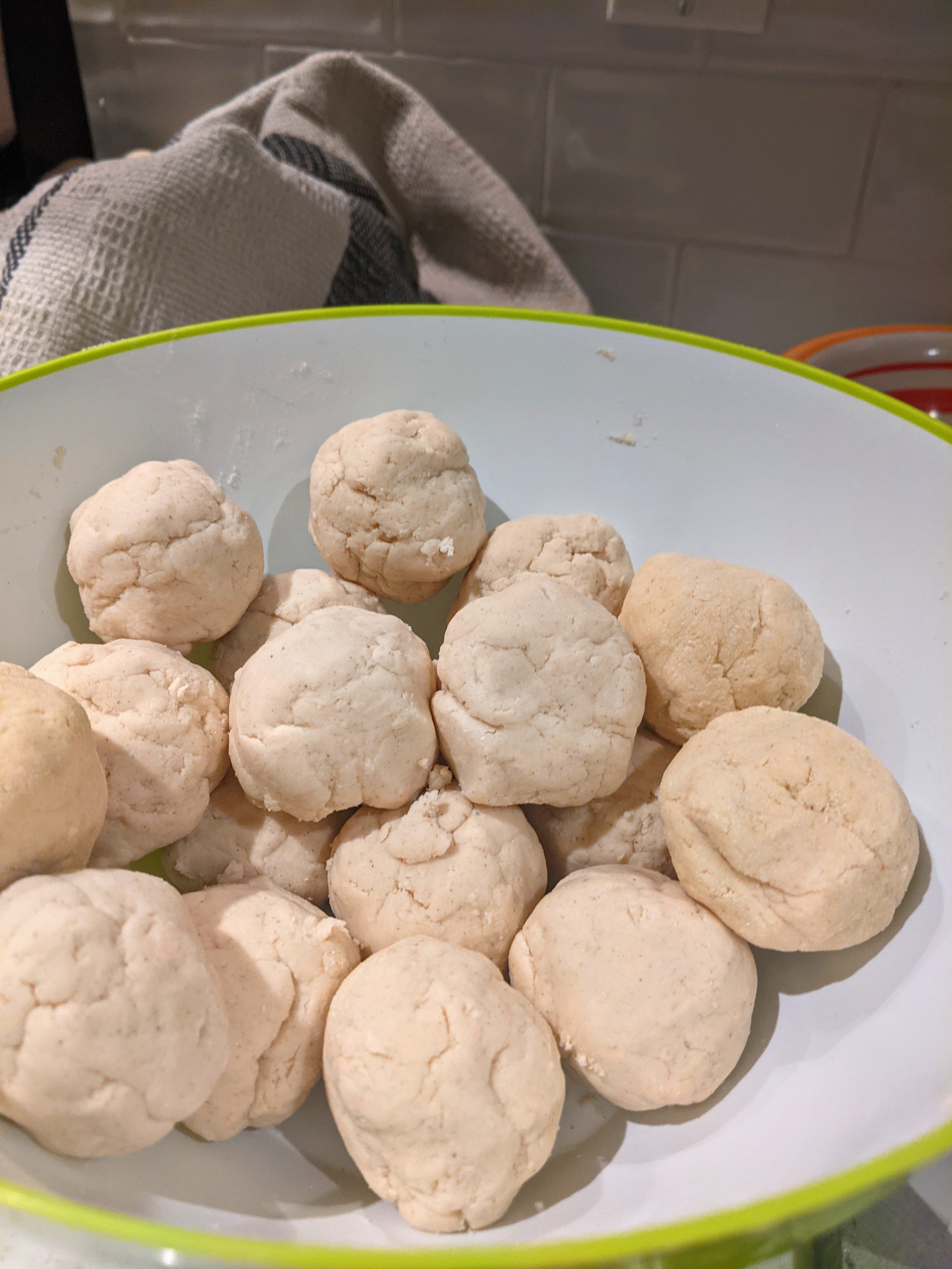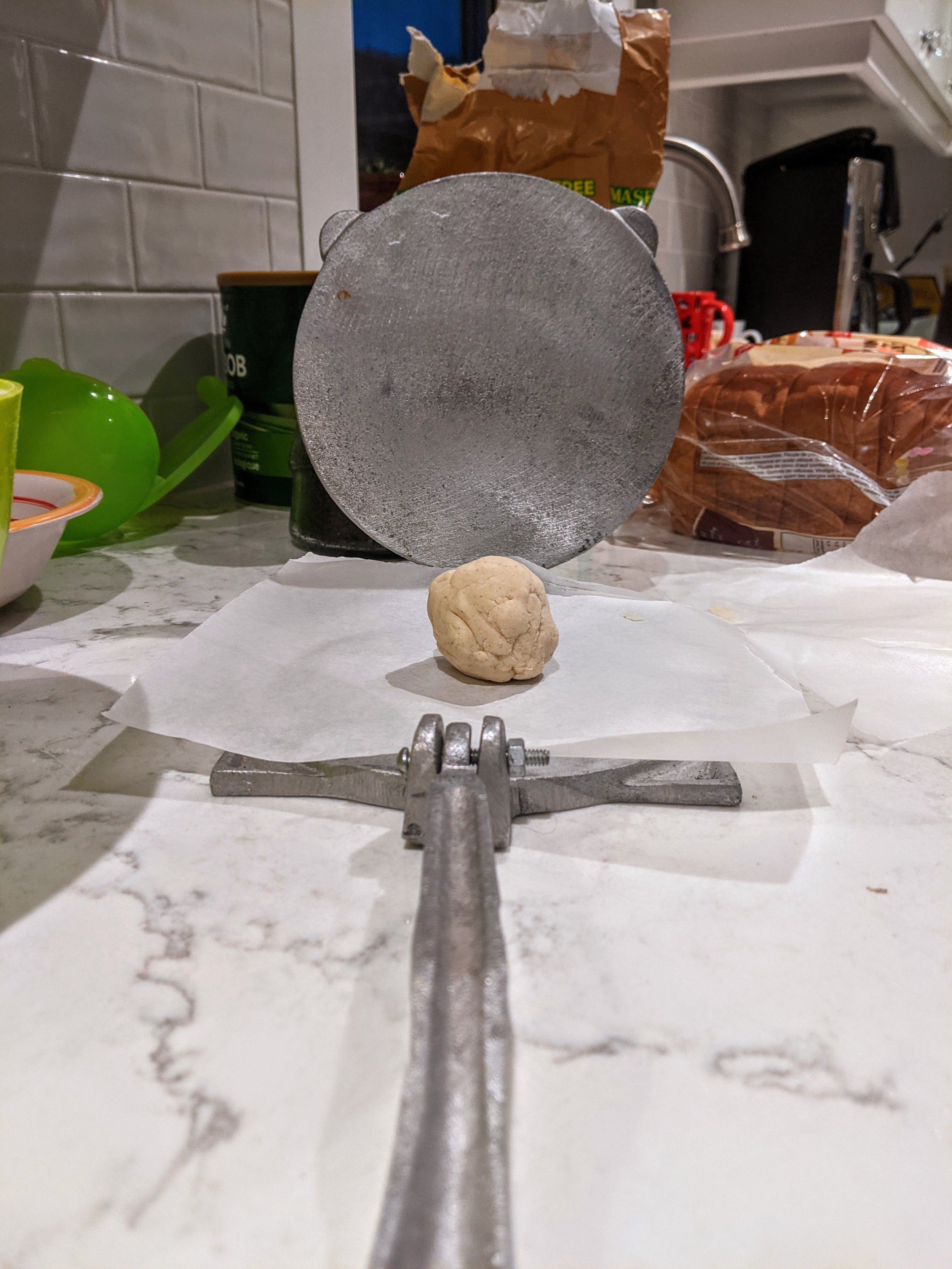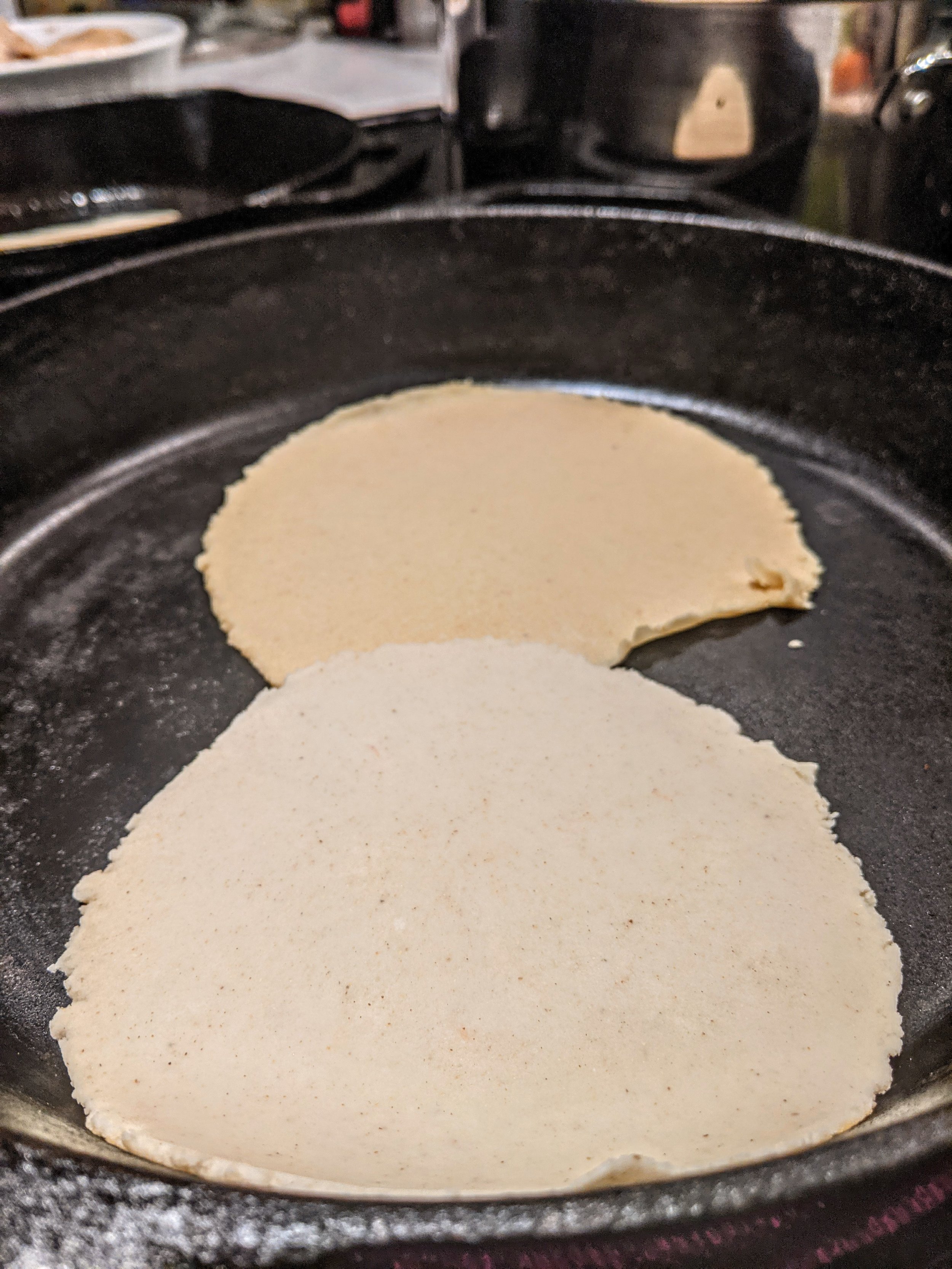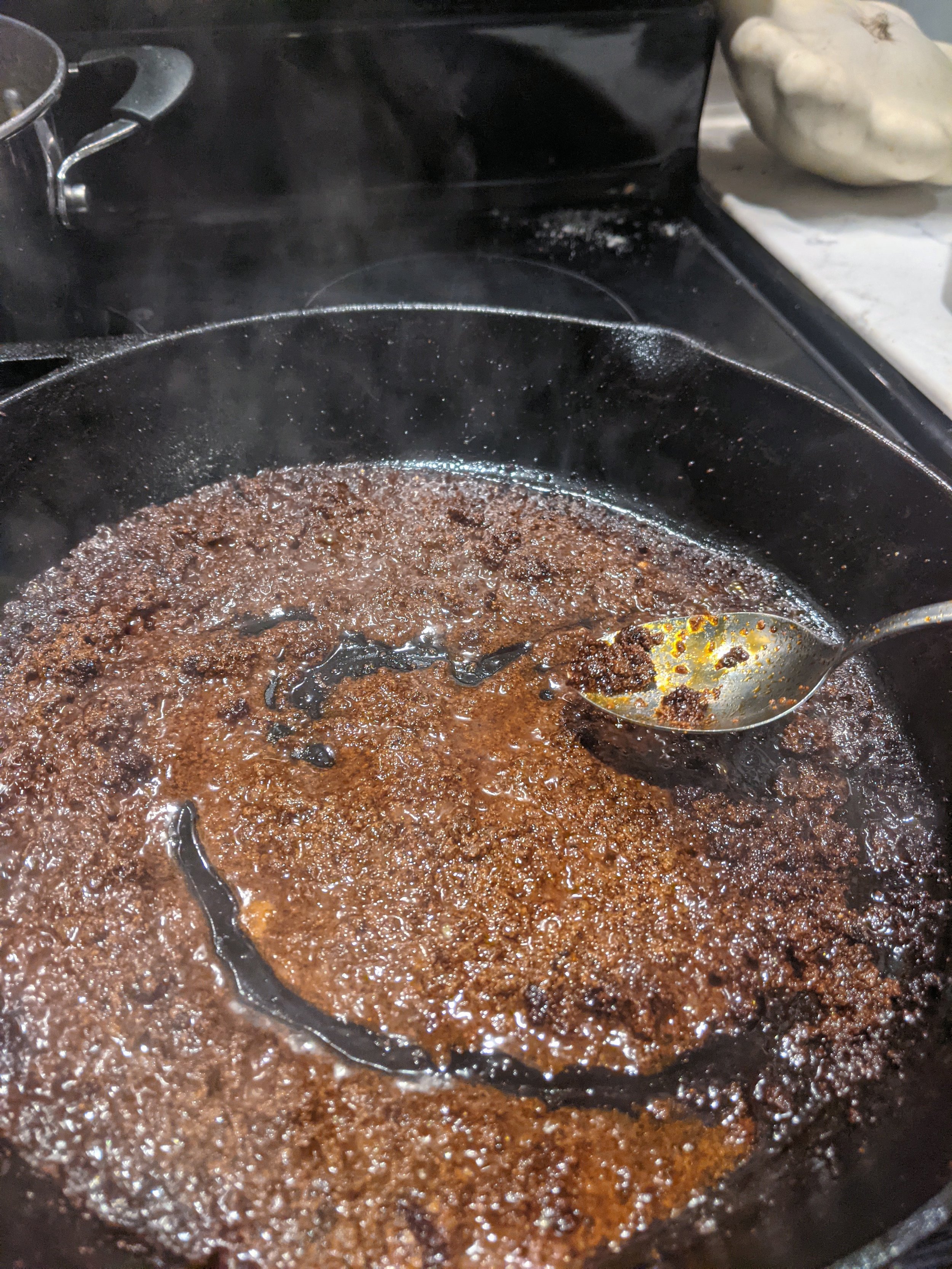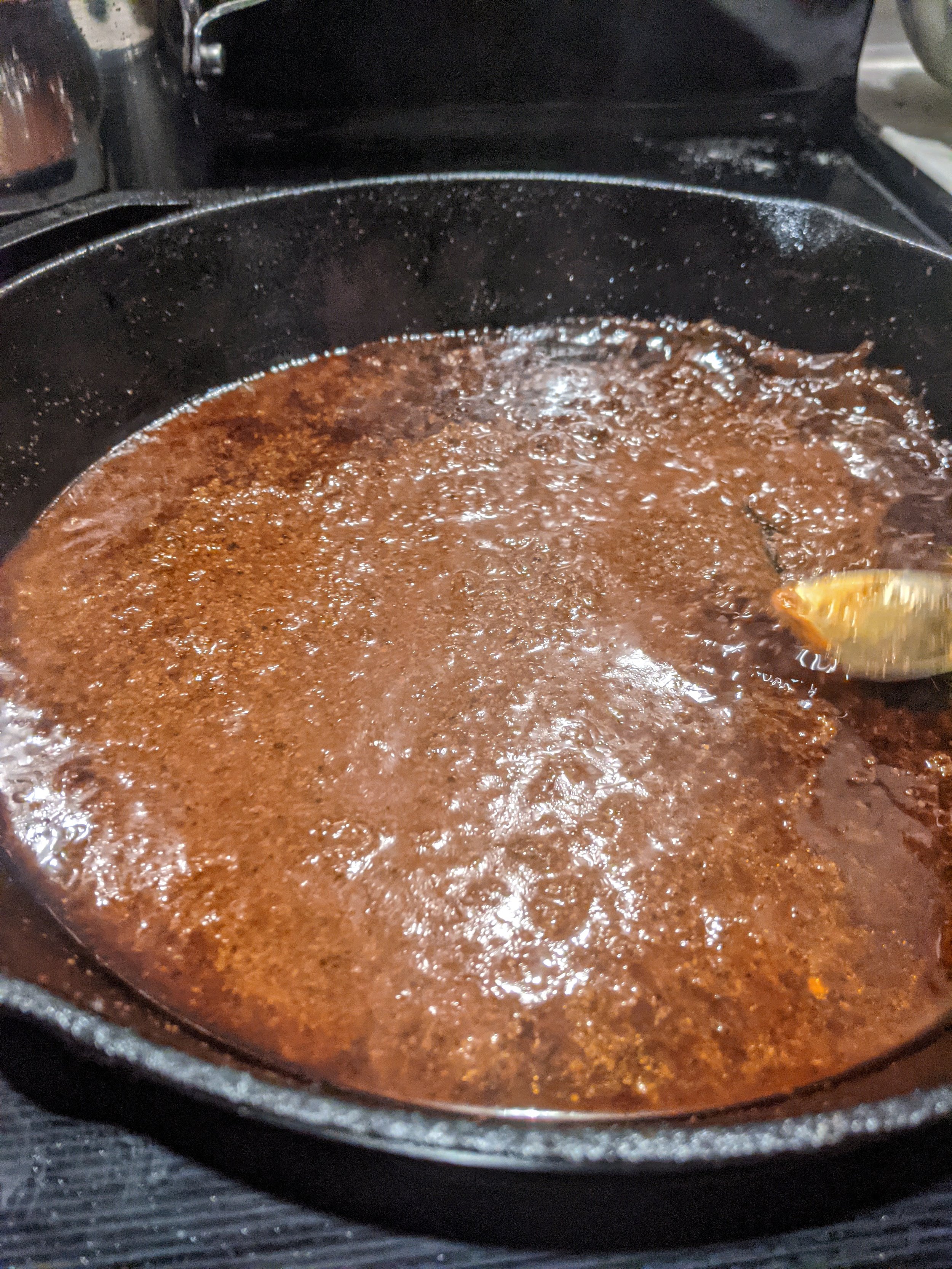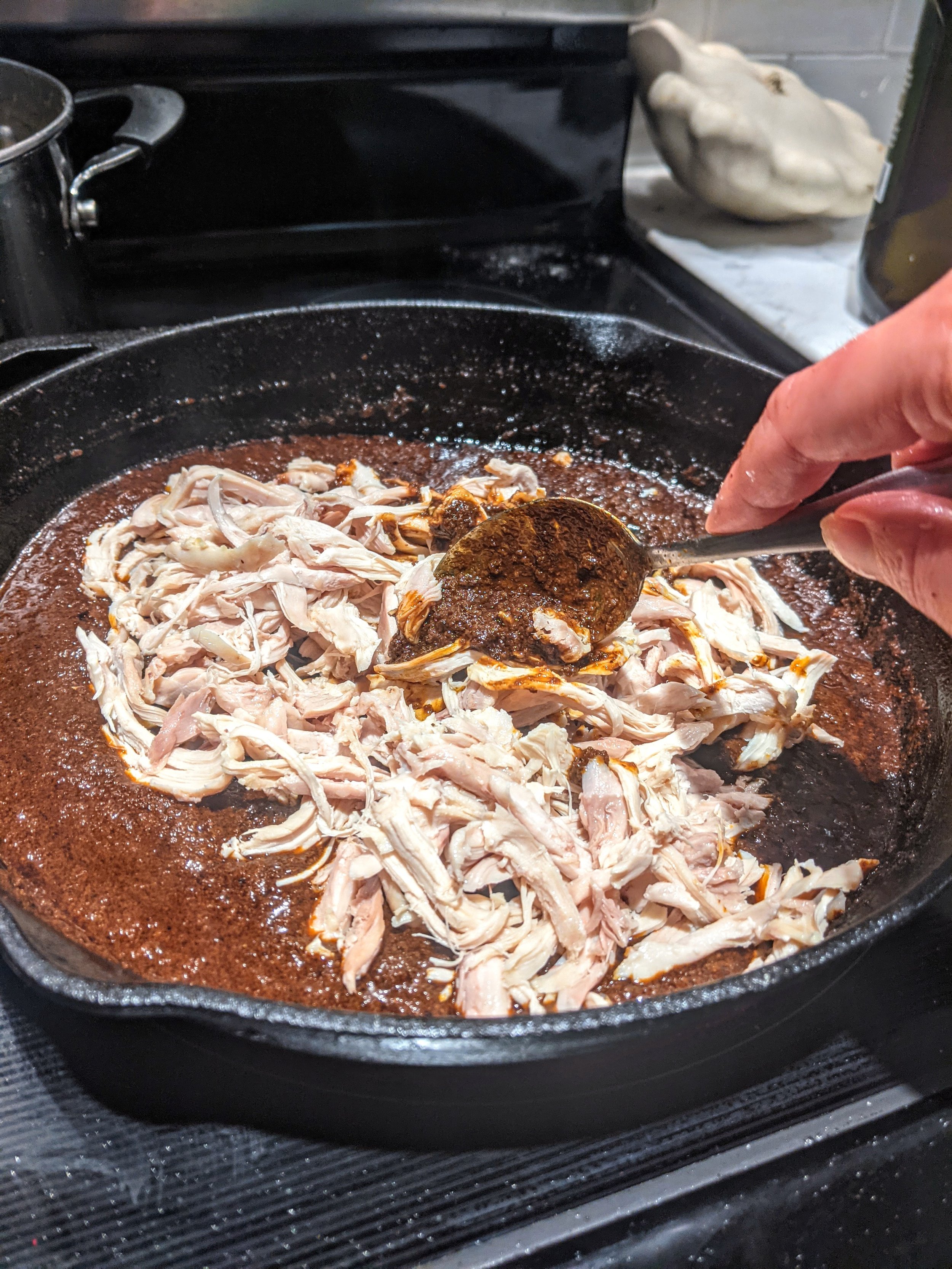Holy Mole

I’ve decided that in order to be adequately prepared for our move to Mexico, it’s important to ready ourselves mentally as well as logistically. We’ve still got a long way to go to get our things in order (and only NINE DAYS to do it!), but what better way to prepare for the culture shock than to partake in some of the culture before we arrive? Like priming a cornstarch slurry with some of the broth your about to add it to instead of clumpily dumping it right into the pot, or tempering eggs with warm liquid to prevent them from scrambling, I decided to try to prime us for what’s to come. What better way than with musica y comida?
Enter Mole Poblano. I’ve tackled this recipe before, and this time I was hoping to make some Enmoladas; juicy pulled chicken, rolled in tender homemade tortillas, covered in a savoury-sweet mole sauce made with homemade chicken broth, topped with a generous drizzle of crema and thinly sliced white onion.
The first step is to put on some quintessential latin music, Cumbia. Cumbia is best when it’s played a little too loud. It prevents me from concentrating too hard on cooking. Like sipping on a glass of wine during dinner prep, it keeps things light. I recommend Las Angeles Azules, especially anything featuring Natalia Lafourcade. The steady Latin beat had my clumsy tight white lady hips groovin’…sort of. Perfect.
So it doesn’t look good, YET. Check out all that delicious oiliness bubbling to the surface. That tells you it’s going to be good.
Next? El pollo. Imitating the method I learned from the lovely Laura Justo Garza (who we stayed with in Mexico City on our first trip to the fun side of the wall), I began my afternoon long labour of love.
I used chicken thighs, bone-in and skin on (not just because that’s the cheapest way you can buy chicken these days, but also because it’s the best kind of chicken to buy). I tossed eight or so into a large pot of well salted water with a quartered onion, two or three bay leaves, and a few smashed cloves of garlic. Once the water began to boil, I turned the heat down to a simmer and let the chicken bob away with the aromatics for 20-30 minutes. Strangely, it took me back to our days of naked hot spring hopping; maybe it was the fleshy, pale, goosebumped skin. All I can say is thank God for the Cumbia to pull me out of my nostalgic ennui.
It’s just shredded chicken. Do you really need a caption?
Pulling the chicken pieces out of the water with a slotted spoon, I allowed them to cool (after burning my fingers on the hot, slippery skin) before I began pulling the chicken apart with my hands. This is a labour of love, people! Using utensils to shred chicken is tantamount to being sacrilege in Mexico. It also takes way longer, and is less fun. When it was cool enough to handle, I ripped the rubbery skin off the thighs, slipped the bones out (it was so perfectly tender that the bones actually did slide right on out!) and began pulling the meat apart in thin strips that dripped with slick, oily juiciness. The water (now broth) also had a sheen of fat on the top (thanks to cooking the chicken pieces whole). As it cooled, it began to gel just a little; the result of the melted connective tissue that was extracted from the thighs as they boiled away.
This stuff is yellow corn, but I usually see the white bags in the stores, which of course, is white corn.
Next, because I don’t have access to the fresh perfectly pressed corn tortillas that can be had on almost every street corner in Mexican towns and cities, I commenced to make my own. It’s easier than it sounds, but only because I bought a tortillera before we left Mexico last time. The ingredients are simple enough. Corn masa, salt, warm water. That’s it. If you’re gonna make these at home, make sure you get corn masa, not corn flour. Corn flour, or corn meal are not made with “nixtamalized” corn and cannot be used as a substitute. You can find corn masa in most major grocery stores in Canada. The only brand I’ve seen is “Maseca” brand, which is popular in Mexico, too, though not the only option that can be had there.
ANYWAY, to make the tortillas, measure out equal parts Maseca and warm water (or liquid). I was feeding four of us, and wanted to make larger tortillas (to roll the chicken in for enmoladas), so I used four cups of masa and three cups of cooled chicken broth, and a cup of warm water. In a large bowl, I added the masa and seasoned it with salt. Mix it well to evenly distribute the salt. I always start with adding only 3/4 of the liquid. With my hands (does anyone else take extreme pleasure from squishing pale, slightly fleshy dough between their fingers? Take your rings off, ladies) I mixed the masa and water until it began for form a soft dough. You CAN do this with a fork or rubber spatula, but why would you want to? As it turns out, I take extreme pleasure from squishing pale, slightly fleshy dough between my fingers. This has nothing to do with hot spring memories, I swear. Now is a good time to remember to take off your rings. Slowly I add a little more liquid until there’s no more dry masa in the bowl and the dough is soft and squishy but not sticky. I aim for play-doh consistency. To make the pressing process fast and easy, I like to rip hunks off the dough and roll them into balls (golf ball sized for smaller tortillas, hacky sack sized for large ones). I like to place a damp tea towel over the bowl to avoid drying out my balls….
To turn your masa balls into tortillas, you have a few options. You can use a tortilla press (don’t forget to use parchment paper above and below your masa ball to keep it from sticking to the press), you can squish them down on your counter with the bottom of a heavy pan or pot (again, use some parchment), or you can use your hands. The press will make the thinnest tortillas, your hands will make the thickest (like you’d find in Guatemala instead of Mexico). This is the only step that I prefer to use an instrument instead of my hands. For enmoladas you’ll need the thinnest ones you can make. Mine still weren’t thin enough. More on that later.
While you’re pressing the tortillas, get a pan ripping hot. I like a cast iron skillet (or flat top), but any really hot, wide frying pan will do. The tortillas don’t take too long to cook. I let them cook for about 30 seconds per side. It’s ok if they start to puff and form pockets. This means they’re done. If they don’t puff up, you’ve ruined the entire thing and have to toss out all the masa and start again. Just kidding. They’re still tasty and delicious even if they do play dead in the pan. I keep the cooked tortillas wrapped in a dry tea towel to keep them warm and supple.
SO, as I mentioned before, my tortillas weren’t thin enough to roll. Instead of beating my head against the counter when faced with my obvious inadequacy, I reminded myself that it’s really hard to get them thin enough to roll, even with a press. The tortillas that you buy in a tortilleria in Mexico are a different breed entirely and practically impossible to replicate at home…well, practically impossible for ME to make at home. Instead, I decided to make tacos. Same ingredients, different application (like most of Mexico’s best foods).
Next step is the mole sauce. I have mole paste, so I didn’t have to make it. You can make your own (I know there are good recipes for this online, but thank GOD I didn’t have to execute any of them), or you can buy a paste to which you can add broth (or failing that, water…try not to use water, please) to turn it into a sauce. It might be hard to find paste unless you’re in a big city, but you can buy it on Amazon (ew) if you’re desperate: (https://www.amazon.ca/Mole-Poblano-Paste-KG-brick/dp/B002EX19JW/ref=sr_1_3?keywords=mole+paste&qid=1636229353&sr=8-3)
With my slightly cooled cast iron skillet, I swirled around a few tablespoons of olive oil until it shimmered and slid easily around the pan. Then, I added about a quarter cup of mole paste and mashed and stirred vigourously until the gritty paste began to smooth out. I’ve burned the paste in too hot a pan before. At this point, you really HAVE ruined it all and will need to start again. Burned mole is seriously no bueno. When the paste begins to smell fragrant and warm I start to add some of the leftover broth from boiling the chicken. I don’t measure during this step, but you want a thick consistency. Pourable, but not thin or runny. It’ll thickly coat the back of the spoon. Ya know? The result will be slightly salty, slightly smoky, a little oily and a little sweet (mole poblano is made with chocolate, after all). So, because of the change in plans, instead of pouring the mole sauce over tightly rolled tortillas stuffed with shedded chicken (sigh), I decided to toss the chicken in the mole sauce to coat every last succulent morsel. Not a bad move if I do say so myself. This will taste just as good, but to be honest, it just doesn’t turn out as saucy and messy and I’d like.
Salsa Cruda, Pico de Gallo, Salsa Banda. Whatever you call it, it’s damn tasty.
To make the crema (because I have yet to find really good crema in Canada), I took extra thick sour cream (the 18% stuff is best, but I’ll forgive you if you use 14%), and poured in a generous amount of heavy cream (the high fat, 33% whipping stuff). I whisked this until it was fully homogenous (yes, homogenous), and you know what? It really does compare to traditional Mexican crema. It’s thinner than sour cream (so you can drizzle it), and not as tangy (thanks to the fatty sweetness of the heavy cream).
I also made a quick salsa cruda. Coarsely chop a few tomatoes, half an onion, a jalapeno, and some cilantro. Add to a blender or food processor (or Chef’s Rival MANUAL food processor as you can see here) with the juice of a lime, a crushed garlic clove (or two!), and a generous pinch of salt and pepper, and, um, “process,” until everything is finely chopped and well mixed. Here we call it Pico de Gallo, and although I’m sure they use the term SOMEWHERE in Mexico, I’ve never heard it down there. It’s just plain old “salsa”. It’s cruda because I didn’t roast or blacken any of the ingredients first.
That’s it. Now you’re gonna stuff those tenderly soft tortillas will your chicken mole, some crema, salsa and a few avocado slices if you have them (I did not), and dig in.
Buen provecho, amigos!



